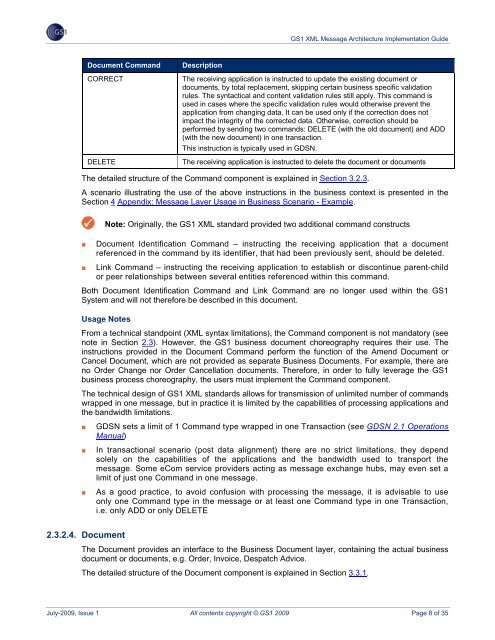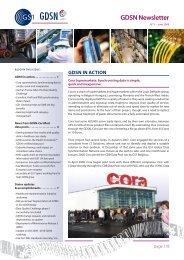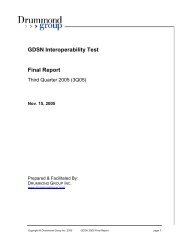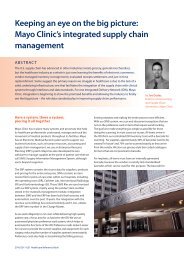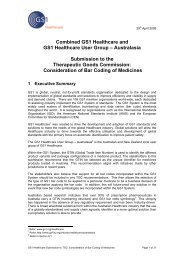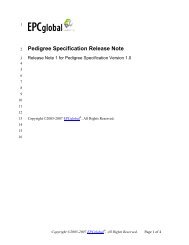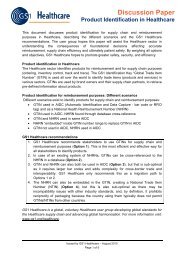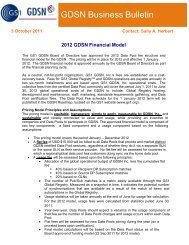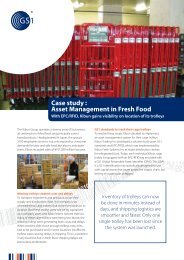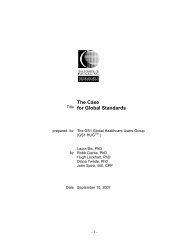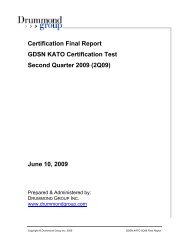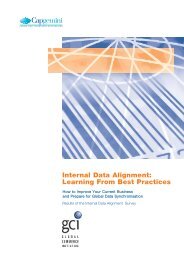GS1 XML Message Architecture Implementation Guide
GS1 XML Message Architecture Implementation Guide
GS1 XML Message Architecture Implementation Guide
You also want an ePaper? Increase the reach of your titles
YUMPU automatically turns print PDFs into web optimized ePapers that Google loves.
<strong>GS1</strong> <strong>XML</strong> <strong>Message</strong> <strong>Architecture</strong> <strong>Implementation</strong> <strong>Guide</strong><br />
Document Command<br />
CORRECT<br />
DELETE<br />
Description<br />
The receiving application is instructed to update the existing document or<br />
documents, by total replacement, skipping certain business specific validation<br />
rules. The syntactical and content validation rules still apply. This command is<br />
used in cases where the specific validation rules would otherwise prevent the<br />
application from changing data. It can be used only if the correction does not<br />
impact the integrity of the corrected data. Otherwise, correction should be<br />
performed by sending two commands: DELETE (with the old document) and ADD<br />
(with the new document) in one transaction.<br />
This instruction is typically used in GDSN.<br />
The receiving application is instructed to delete the document or documents<br />
The detailed structure of the Command component is explained in Section 3.2.3.<br />
A scenario illustrating the use of the above instructions in the business context is presented in the<br />
Section 4 Appendix: <strong>Message</strong> Layer Usage in Business Scenario - Example.<br />
Note: Originally, the <strong>GS1</strong> <strong>XML</strong> standard provided two additional command constructs<br />
■<br />
Document Identification Command – instructing the receiving application that a document<br />
referenced in the command by its identifier, that had been previously sent, should be deleted.<br />
■<br />
Link Command – instructing the receiving application to establish or discontinue parent-child<br />
or peer relationships between several entities referenced within this command.<br />
Both Document Identification Command and Link Command are no longer used within the <strong>GS1</strong><br />
System and will not therefore be described in this document.<br />
Usage Notes<br />
From a technical standpoint (<strong>XML</strong> syntax limitations), the Command component is not mandatory (see<br />
note in Section 2.3). However, the <strong>GS1</strong> business document choreography requires their use. The<br />
instructions provided in the Document Command perform the function of the Amend Document or<br />
Cancel Document, which are not provided as separate Business Documents. For example, there are<br />
no Order Change nor Order Cancellation documents. Therefore, in order to fully leverage the <strong>GS1</strong><br />
business process choreography, the users must implement the Command component.<br />
The technical design of <strong>GS1</strong> <strong>XML</strong> standards allows for transmission of unlimited number of commands<br />
wrapped in one message, but in practice it is limited by the capabilities of processing applications and<br />
the bandwidth limitations.<br />
■<br />
■<br />
■<br />
GDSN sets a limit of 1 Command type wrapped in one Transaction (see GDSN 2.1 Operations<br />
Manual)<br />
In transactional scenario (post data alignment) there are no strict limitations, they depend<br />
solely on the capabilities of the applications and the bandwidth used to transport the<br />
message. Some eCom service providers acting as message exchange hubs, may even set a<br />
limit of just one Command in one message.<br />
As a good practice, to avoid confusion with processing the message, it is advisable to use<br />
only one Command type in the message or at least one Command type in one Transaction,<br />
i.e. only ADD or only DELETE<br />
2.3.2.4. Document<br />
The Document provides an interface to the Business Document layer, containing the actual business<br />
document or documents, e.g. Order, Invoice, Despatch Advice.<br />
The detailed structure of the Document component is explained in Section 3.3.1.<br />
July-2009, Issue 1 All contents copyright © <strong>GS1</strong> 2009 Page 8 of 35


